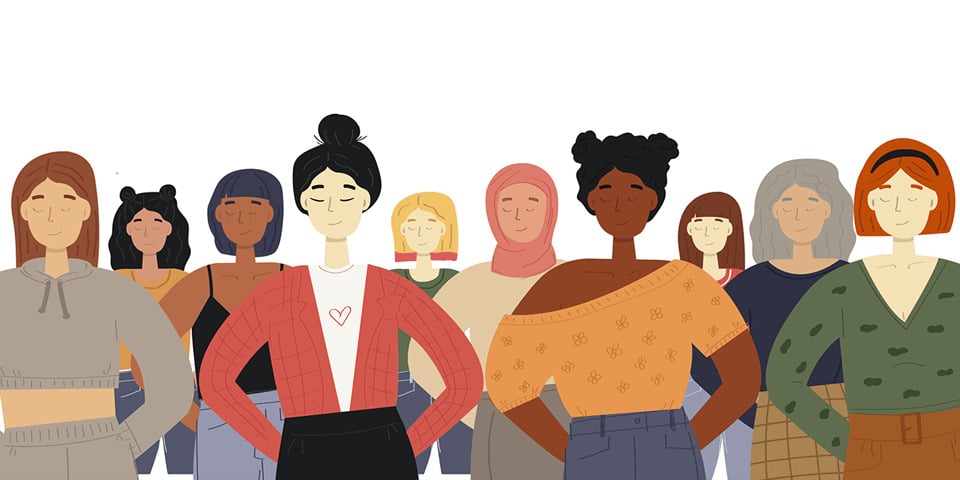Women’s History Month stories: Women who changed reproductive healthcare

Women have been on the forefront of advances in reproductive healthcare for decades. However, the names and accomplishments for some have gone largely unacknowledged until recently. We’re celebrating Women’s History Month with the stories of women who shaped reproductive healthcare throughout history and helped lay the foundation to promote safe and equitable reproductive healthcare for everyone.
In this article
- Jane Sharp (17th century)
- Black midwives (17th century to present day)
- Mary Breckinridge (1881-1965)
- Mary Francis Hill Coley (1900-1966)
- Miriam Menkin (1901-1992)
- Dr. Virginia Apgar (1909-1974)
- Dr. Georgeanna Seegar Jones (1912-2005)
- Dr. Rosalyn Yalow (1921-2011)
- Ruth Fowler (1930-2013)
- Margaret Crane (1941-)
- Jean Purdy (1945-1985)
- Lesley Brown (1947-2012) and hundreds more
- Related Articles
Jane Sharp (17th century)
Jane Sharp is the author of The Midwives Book: Or the Whole Art of Midwifry Discovered, Directing Childbearing Women How to Behave Themselves, published in 1671.1 Up until the 17th century, all midwifery books had been written by men who had no experience in the topic.2 Not much is known about Jane Sharp, though the book’s title page states that she had been a midwife for more than 30 years.1
The book has six sections with illustrations and includes information on male and female sexual anatomy, fertility, conception, care during pregnancy, preparing for labor, the expected roles of the midwife and mother during birth, and information on how to care for a newborn, including breastfeeding, nutrition and more.1 The book may well have been intended for practitioners as well as everyday people — accessibility that likely contributed to its overall popularity. (It was in its fourth edition by 1725.)2
Black midwives (17th century to present day)
According to the National Museum of African American History & Culture, enslaved midwives played vital roles in their communities beginning in the 17th century in the U.S., ensuring the health and well- being of both Black and white women and their children.3,4 They continued their work after Emancipation, and many worked in underserved rural communities.3
In the early 1900s, physicians pushed for healthcare reform, with many blaming a high infant mortality rate on midwifery.4,5 However, for many women in Southern rural communities, access to hospitals and doctors was limited.3 Although healthcare reformers insisted on permits and training, Black midwives continued to play an essential role in helping to deliver babies — a role Black midwives and doulas continue today.3-5
Mary Breckinridge (1881-1965)
According to the American Association for the History of Nursing, Mary Breckinridge was “the driving force behind rural healthcare in America as well as the development of nurse midwives.”6
Mary’s bio is impressive: After volunteering as a nurse in WWI and in Washington D.C. during the influenza epidemic, she went to France on behalf of the American Committee for Devastated France and organized a disaster-relief program for children and pregnant women.7 Later, seeing a need for midwifery skills in rural Kentucky, Mary went to England in 1923 to study at the British Hospital for Mothers and Babies in London.7 While there, she toured nursing stations in the Scottish Highlands to become better informed about rural nursing.7
When Mary returned to rural Kentucky in 1925, she organized the Kentucky Committee for Mothers and Babies in Leslie County, later renamed Frontier Nursing Service; it still exists.7,8 It maintains six rural healthcare clinics in Kentucky, including the Mary Breckinridge Hospital.8
Mary Francis Hill Coley (1900-1966)
Mary Francis Hill Coley was trained by another midwife, Onnie Lee Logan, as was the tradition at the time.9 In a span of 30 years, she delivered more than 3,000 babies in Georgia.9 According to Georgia Women of Achievement, she visited the homes of the Black and white mothers she worked with for days after her deliveries, helping with household chores and filling out forms and certificates.9
In 1952, the documentary filmmaker George C. Stoney spent four months filming Mary to produce “All My Babies,” which was used as an instructional training film distributed by the Georgia Health Department.9 Though perhaps not its original intent, the film highlighted deep systemic inequities in the healthcare system while also showcasing Mary’s skill and advocacy.9
The film received worldwide attention, and in 2002 was selected by the Library of Congress for placement on the National Film Registry.9
Miriam Menkin (1901-1992)
A U.S. scientist, Miriam Menkin conducted in vitro fertilization (IVF) research with U.S. obstetrician and gynecologist and Harvard fertility expert Dr. John Rock. Dr. Rock wanted to cure infertility; to help make his objective a reality, Miriam’s goal was to fertilize an egg outside of the human body.10
According to the British Broadcasting Corporation, she could pinpoint an egg with her naked eye, and she called herself Dr. Rock’s “egg chaser.”10 The lab work was tedious.10 But finally, after six years of daily trial, it worked. In 1944, Miriam looked inside the incubator and saw a fertilized egg.10
Dr. Virginia Apgar (1909-1974)
A U.S. physician, anesthesiologist and medical researcher, Dr. Virginia Apgar developed the Apgar Score System in 1952.11 Still used today, the system allows healthcare providers to evaluate infants shortly after birth to assess their well-being.12 A score is given based on the baby’s heart rate, respiratory effort, muscle tone, reflex irritability and skin color.12
Dr. Apgar, who later served as Director of the Department of Anesthesiology at Columbia-Presbyterian Medical Center, is a member of the National Women’s Hall of Fame and has even been featured on a U.S. postage stamp.13
Dr. Georgeanna Seegar Jones (1912-2005)
Dr. Georgeanna Seegar Jones was the first person to demonstrate that the pregnancy hormone (which we now call human Chorionic Gonadotropin, or hCG) arose from the placenta rather than the pituitary gland — and she did it as a medical student!14 Dr. Jones also established the Division of Reproductive Endocrinology at The Johns Hopkins Medicine Institutions along with her husband, Dr. Howard W. Jones Jr., in 1939.14
In 1949, she was the first person to describe the “luteal phase defect” in infertility.14 She served as co- editor-in-chief of “The Obstetrical and Gynecological Survey” from 1957 to 1989.14 In 1978, Dr. Jones established the Jones Institute for Reproductive Medicine at Eastern Virginia Medical School, the first IVF program in the U.S.14 Her work helped contribute to the birth of the U.S.’s first IVF baby in 1981, Elizabeth Carr.15
Dr. Rosalyn Yalow (1921-2011)
A nuclear physicist, Rosalyn Yalow, Ph.D., developed radioimmunoassay (RIA) together with Dr. Solomon Berson, which earned them the Nobel Prize in Physiology or Medicine in 1977.16 This discovery enabled more than 100 biochemical substances to be measured down to the billionth of a gram, including hormones that can be used to diagnose infertility.17,18 According to The Nobel Foundation, Dr. Yalow conducted her research at the VA Medical Center in Bronx, New York, from 1947 to 1991.17 While working at the VA, she had two children.17 At the time, the VA had a policy that once you were five months pregnant, you had to leave.17 Dr. Yalow ignored it.17
Ruth Fowler (1930-2013)
U.K.-based scientist Ruth Fowler and her husband, Edward Fowler, figured out how to increase the number of synchronized eggs recoverable from adult female mice in the late 1950s.19 Ruth then spent many years supporting her husband’s work in the laboratory and raising their five children.19 In the early 1970s, Ruth returned to the lab and published many papers on topics such as the growth of human embryos, genetics of human development, progesterone and protein composition of uterine fluids in rabbits, and follicular development.19
Margaret Crane (1941-)
A U.S. inventor and graphic designer, Margaret Crane designed the first home pregnancy test in 1967 while working at Organon Pharmaceuticals when she was 26 years old.20 Margaret was hired to design packages for cosmetics, such as lipsticks.20
Smithsonian Magazine interviewed Margaret in 2015. When thinking about the hundreds of pregnancy tests sent by doctors to Organon, she thought about how easy it would be to design packaging for women to test at home. “It’s so simple, just a test tube and a mirrored surface. A woman could do that herself,” she says in the article.20 Her prototype, which she called The Predictor, included a dropper, vial, rack and mirror.20 It was recently acquired by the Smithsonian National Museum of American History.20
Although Margaret’s name was on the patent when Organon licensed it out, because she was an employee of the company, she had to sign away her rights to earn money from her innovation.20 The first consumer product from her prototype was manufactured in Canada in 1971.20
Jean Purdy (1945-1985)
A pioneer of fertility treatment, Jean Purdy helped develop IVF along with Dr. Robert Edwards and Dr. Patrick Steptoe.19,21 Their work in the U.K. resulted in the birth of Louise Joy Brown, the first human born by IVF.21 Dr. Edwards was awarded the Nobel Prize in Physiology or Medicine in 2010 for this achievement; however, by this time, Jean had died, as had Dr. Steptoe.22 (Nobel Prizes aren’t awarded posthumously.)22 For decades, Purdy’s name was continually ignored.19,22
In 2019, Dr. Edwards’ letters were released from the University of Cambridge archives, revealing that he had repeatedly appealed that Jean be recognized as much as he and Dr. Steptoe had been, including featuring her name on a plaque in 1978.22 Although a new plaque with Jean’s name was unveiled in 2015, the letters reminded the world once again that their work was the result of a trio, not a duo.22
Lesley Brown (1947-2012) and hundreds more
After trying to conceive for nine years, Lesley Brown was among the several hundred patients who volunteered for an experimental IVF procedure resulting from the work of Jean Purdy, Dr. Edwards and Dr. Steptoe.19,23,24 In 1978, Lesley and her husband gave birth to their daughter, Louise Joy Brown, whom the media dubbed the world’s first “test-tube baby” in the U.K.23,24 Lesley’s courage to try something new — along with 282 additional patients who did not get pregnant despite going through the same experimental IVF procedures from 1969 to 1979 (some four-plus times) — have now given millions of couples the ability to conceive this way.19
It has always been our mission at Clearblue® to put women at the heart of everything we do — from education and technological development to design, research, clinical studies, field trials and testing. Our mission is to transform the way women manage their reproductive health, and to support those working tirelessly to promote safer and equitable reproductive healthcare for all. These women have paved the way for today’s reproductive healthcare advocates and champions, and for those still to come.
Related Articles
Sources :
-
Sharp J. The midwives book, or, the whole art of midwifry discovered: directing childbearing women how to behave themselves in their conception, breeding, bearing, and nursing of children in six books. Text Creation Partnership. 1671. Accessed January 31, 2023. https://quod.lib.umich.edu/cgi/t/text/text-idx?c=eebo2;idno=A93039.0001.001
-
Gonville & Caius, University of Cambridge. Jane Sharp 1641-1671. Accessed January 5, 2023.https://www.cai.cam.ac.uk/discover/library/online-exhibitions/her-book/authors/jane-sharp-16411671
-
National Museum of African American History & Culture. The historical significance of doulas and midwives. Accessed January 6, 2023.https://nmaahc.si.edu/explore/stories/historical-significance-doulas-and-midwives
-
Terrell E, Library of Congress. Honoring African American contributions in medicine: midwives. Updated June 18, 2020. Accessed January 31, 2023.https://blogs.loc.gov/inside_adams/2020/06/honoring-african-americancontributions-in-medicine-midwives/
-
Tobbell D, University of Virginia School of Nursing. Black midwifery’s complex history. Updated February 12, 2021. Accessed January 31, 2023.https://www.nursing.virginia.edu/news/bhm-black-midwives/
-
American Association for the History of Nursing. Mary Breckinridge 1881-1965. Accessed January 5, 2023. https://www.aahn.org/breckinridge
-
Shampo MA, Kyle RA. Mary Breckinridge—pioneer nurse brings modern nursing to rural environment. Mayo Clin Proc. 1999;74(12):1312. doi: 10.4065/74.12.1312. Accessed January 31, 2023.https://www.mayoclinicproceedings.org/article/S0025-6196(11)64180-3/fulltext
-
Frontier Nursing University. History of FNU. Accessed January 5, 2023. https://frontier.edu/about-frontier/history-of-fnu/
-
Georgia Women of Achievement. Mary Francis Hill Coley. Accessed January 6, 2023.https://www.georgiawomen.org/mary-francis-hill-coley
-
Gross RE, BBC. The female scientist who changed human fertility forever. Updated January 5, 2020. Accessed January 31, 2023. https://www.bbc.com/future/article/20200103-the-female-scientist-who-changed-human-fertility-forever
-
Britannica. Virginia Apgar. Accessed January 6, 2023. https://www.britannica.com/biography/Virginia-Apgar
-
The American College of Obstetricians and Gynecologists. Committee opinion No. 644: the Apgar score. Updated 2021. Accessed January 24, 2023.https://www.acog.org/clinical/clinical-guidance/committee-opinion/articles/2015/10/the-apgar-score
-
National Women’s Hall of Fame. Virginia Apgar. Accessed January 12, 2023.https://www.womenofthehall.org/inductee/virginia-apgar/
-
U.S. National Library of Medicine, Changing the Face of Medicine. Dr. Georgeanna Seegar Jones. Updated June 3, 2015. Accessed January 31, 2023. https://cfmedicine.nlm.nih.gov/physicians/biography_291.html
-
Holley J, Washington Post. Georgeanna Jones dies at 92; in vitro fertilization pioneer. Updated March 28, 2005. Accessed January 31, 2023. https://www.washingtonpost.com/wp-dyn/articles/A5761-2005Mar27.html
-
The Nobel Prize. Rosalyn Yalow facts. Accessed January 5, 2023.https://www.nobelprize.org/prizes/medicine/1977/yalow/facts/
-
The Nobel Prize. Rosalyn Yalow: Nobel Prize in physiology or medicine 1977. Accessed January 5, 2023.https://www.nobelprize.org/womenwhochangedscience/stories/rosalyn-yalow
-
Gellene D, The New York Times. Rosalyn S. Yalow, Nobel medical physicist, dies at 89. Updated June 1, 2011. Accessed January 31, 2023.https://www.nytimes.com/2011/06/02/us/02yalow.html
-
Johnson MH. IVF: the women who helped make it happen. Reprod Biomed Soc Online. 2018;8:1-6. doi: 10.1016/j.rbms.2018.11.002. Accessed January 31, 2023. https://www.sciencedirect.com/science/article/pii/S2405661818300431
-
Catlin R, Smithsonian Magazine. The unknown designer of the first home pregnancy test is finally getting her due. Updated September 21, 2015. Accessed January 31, 2023.https://www.smithsonianmag.com/smithsonian-institution/unknown-designer-first-home-pregnancy-test-getting-her-due-180956684/
-
Orbach C, Science Museum. Jean Purdy – the forgotten IVF pioneer. Updated July 9, 2018. Accessed January 31, 2023. https://blog.sciencemuseum.org.uk/jean-purdy-the-forgotten-ivf-pioneer/
-
Magra I, The New York Times. Three created a fertility revolution with I.V.F., but one, a woman, went unrecognized. Updated June 11, 2019. Accessed January 31, 2023.https://www.nytimes.com/2019/06/10/world/europe/jean-purdy-ivf-plaque.html
-
Time. 100 women of the year, 1978: Lesley Brown. Updated March 5, 2020. Accessed January 31, 2023.https://time.com/5793654/lesley-brown-100-women-of-the-year/
-
Henig RM, The New York Times Magazine. Lesley Brown. Accessed January 31, 2023.https://archive.nytimes.com/www.nytimes.com/interactive/2012/12/30/magazine/the-lives-they-lived-2012.html?view=Lesley_Brown




